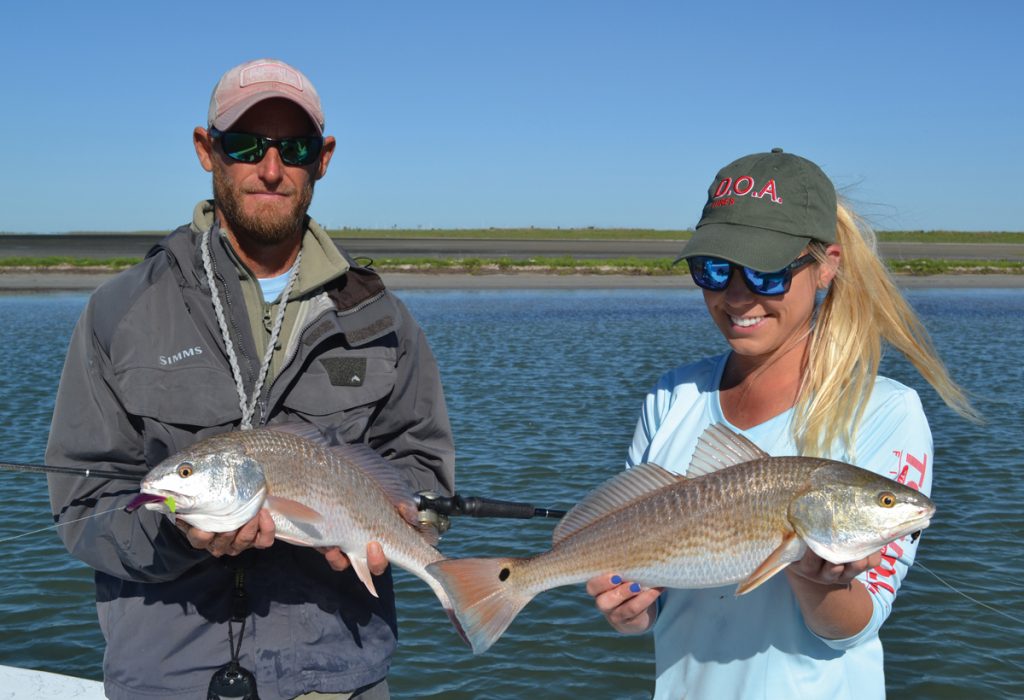
Capt. Bartt Caron and myself doubled-up on slot redfish while drifitng Land Cut. D.O.A. 3” C.A.L. Shad Tail in 350 Purple/Chartreuse and 4” C.A.L. Jerk Bait in 455 Texas Croaker. Photo: Brian Barrera
UPPER LAGUNA MADRE – BAFFIN BAY – LAND CUT
By Kelly Groce

Bill Carson of Humminbird, was all smiles and laughs while catching trout on D.O.A. 4” C.A.L. Jerk Bait in 455 Texas Croaker. Photo: Kelly Groce
Early in April, I got a call from talented fishing guide, surfer and all around waterman, Capt. Joey Farah, that reminded me of one of my favorite songs by Texas country singer, Gary P. Nunn, “Meet Me Down in Corpus.” Joey invited me to fish the Upper Laguna Madre area with D.O.A. Fishing Lures for their spring Outdoor Writers Event. Baffin Bay and Land Cut are places that I’ve dreamed of fishing for quite awhile and these writers events are always a blast, so without hesitation I was in.
Let me familiarize you with the Land Cut if you don’t know already. Land Cut is a 25-mile stretch of the Intracoastal Waterway between Padre Island and Port Mansfield. On one side you have the Padre Island National Seashore and on the other side is the Kenedy Ranch. It’s a beautiful and remote area that takes about an hour by boat to get to. The fishing is phenomenal there and without a doubt one of the prettiest stretches of the Texas coast I’ve laid eyes on.
My fishing buddies for the event were Bill Carson, Field Marketing Manager of Humminbird, and Capt. Brian Barrera, D.O.A. Fishing Lures’ Manager of Marketing and Business Development, and a fishing guide on South Padre Island that specializes in catching snook and tarpon. Our fishing guide was Capt. Bartt Caron. Bartt is an extremely knowledgeable big trout fisherman that knows the Upper Laguna Madre like the back of his hand. When he speaks about fishing, you listen. Bartt owns a beautiful 25’ Haynie Bigfoot with a 350HP Mercury on the back. That thing hauls ‘tater!

Not only does Capt. Brian Barrera like throwing a D.O.A. Bait Buster in 372 Pearl/Green/Red Chin, but trout like eating it too. Photo: Kelly Groce
DAY 1 OF FISHING
When I say a front blew in that morning, I mean a front blew in that morning. There were wind gusts up to 53 mph and it was raining sideways by 5:15 a.m. After the front passed, there wasn’t a cloud in the sky and everyone met at Marker 37 Marina, which is on Padre Island right beside the JFK Causway.
Bartt, Bill, Brian and myself loaded up the boat and ran towards the King Ranch Shoreline. Bartt threw out the drift sock and we started doing some pretty fast drifts since the wind was still howling in the 30mph range. We fished hard til about 4:30 p.m. Everyone caught fish, but Bill was on top of the leader board catching some chunky trout throughout the breezy day. The 4” C.A.L. Jerk Bait in 455 Texas Croaker was definitely the ticket.
That evening back at the condo, we all congregated around as Capt. Joey Farah and Capt. Braeden Thomas fried some drum, redfish, and trout from the day’s fishing trips. Bill Carson made his famous key lime pie for us, which was a real treat. It’s always a good time talking and hanging out with the D.O.A. crew; Mark Nichols, Ed Zyak, Brian Barrera, Ruby Delgado, and Taylor Garcia. Also in good company was Cindy Nguyen, Johnny Lu, Taylor Winzeler, Robert Sloan, Dustin Cartrett, Bartt Caron, Bill Blodgett, Andrew Lassiter, Rocky Guerra and his wife Silver.
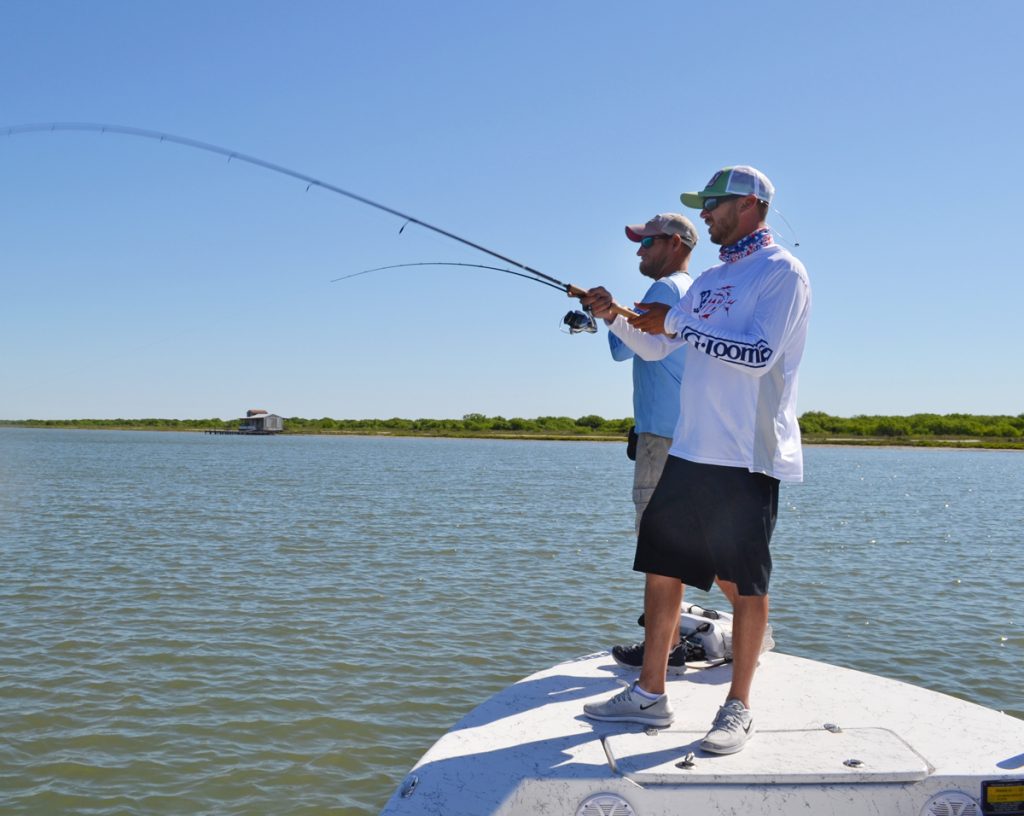
Good Friday was a perfect morning of fishing. Photo: Kelly Groce
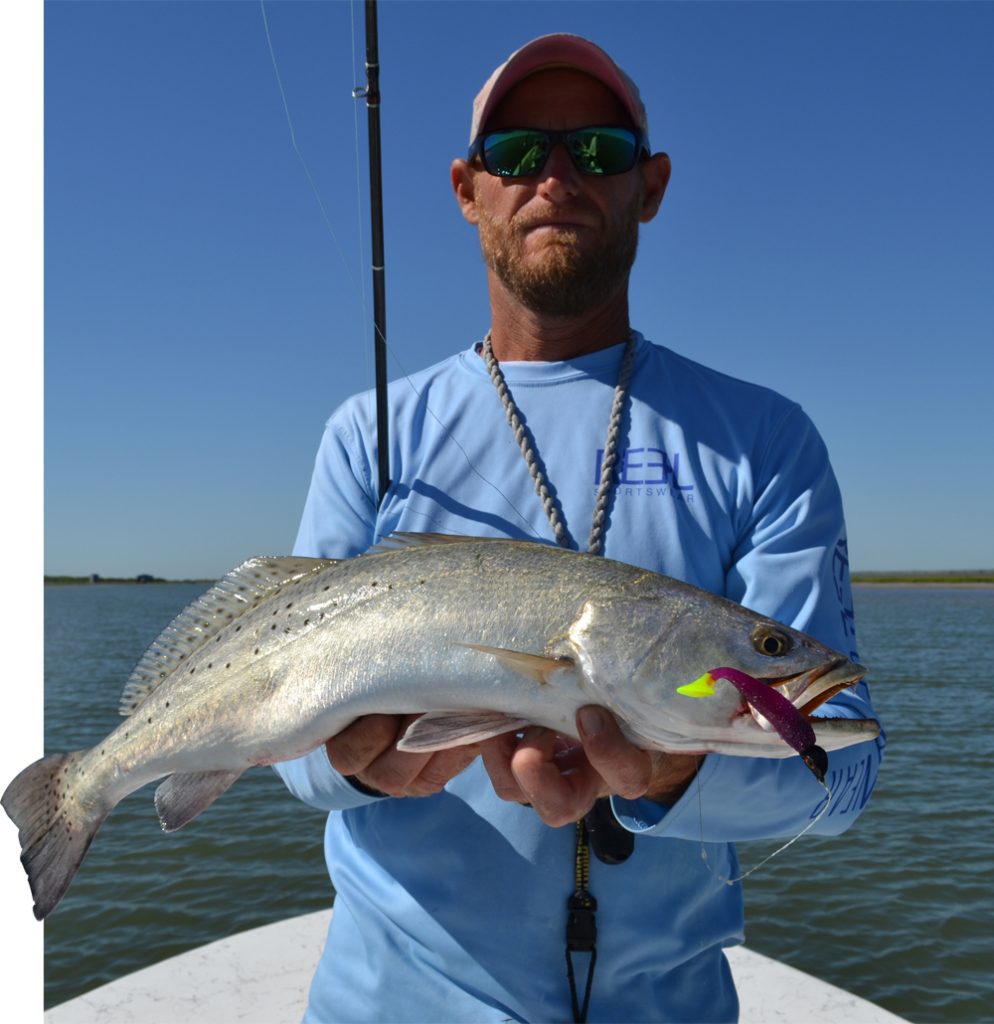
Capt. Bartt Caron with a healthy Land Cut trout caught on a 3” C.A.L. Shad Tail in 350 Purple/Chartreuse.
Photo: Kelly Groce
DAY 2 OF FISHING
Good Friday was blissful with warm temps and blue skies. Everyone was at Marker 37 Marina by 6:15 a.m. Red Bull, cold beer, D.O.A. lures, great people – check! We got to Land Cut in no time, thanks to Capt. Bartt’s Haynie, and began our drift. Since Land Cut is part of the ICW, it has shallow flats on each side with a drop off to about 12 feet of water in the middle. I was positioned at the back of the boat and started working my 4” C.A.L. Texas Croaker Jerk Bait on a 1/4 oz. D.O.A. jig head on the flats through grass and patches of sand. Before long I was hooked up on a slot redfish. Bartt and Brian were both sticking some nice trout where the flat dropped off to deeper water. They were using the 3” C.A.L. Shad Tail in Purple/Chartreuse and 4” C.A.L. Jerk Bait in Texas Croaker. We drifted for 2 hours and steadily caught nice fish. At one point Bartt and myself doubled up on slot redfish. It doesn’t get much more fun that that. Capt. Bartt also scored a bonus flounder shortly after. We got to a slough where Bart caught a solid trout. Brian switched up to a D.O.A. Bait Buster in 372 Pearl/Green/Red Chin. I took photos and watched the guys as they caught trout back-to-back and had double hookups. Bartt finished the day off with an upper slot redfish that we all watched charge at a 3” C.A.L. Shad Tail in Purple/Chartruese on the flats. Seeing the wake from a hungry redfish is always a cool sight to see.
Another guide on the trip, Capt. Braeden Thomas, invited everyone to meet at his family’s fishing cabin on Baffin Bay. We pull up to the dock and I’m looking at a piece of Texas paradise. Joey and Braeden gave me a tour of his place that has been in the family for over 80 years. It was like a time warp to the 50’s inside. Old fishing lures, maps, catch of the day photos, and all types of other nautical nick-knacks covered the ceiling and walls. I’ve never seen a place more perfect in all of my life. From inside the cabin you can see the crystal clear water of Baffin Bay through the windows. I couldn’t think of a better way to spend the afternoon than at Braeden’s fishing cabin.

This fishing cabin, overlooking the pristine waters of Baffin Bay, has been in Capt. Braeden Thomas’ family for over 80 years. Photo: Kelly Groce
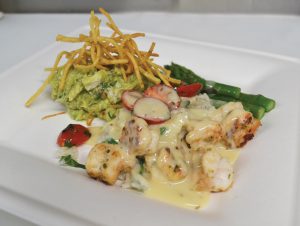
Our delicious meal prepared by Chef Jeff at Fishtales Bar & Grill at Marker 37 Marina. Photo: Kelly Groce
Cindy Nguyen, Ruby Delgado and myself ended the day at Fishtales Bar & Grill at Marker 37 Marina. It was very nice walking straight off the boat to a restaurant on the water. We enjoyed a cold Modelo and conversated as Chef Jeff prepared our post-fishing meal. Chef Jeff graduated from Johnson & Wales College, which is one of the leading culinary institutions in the country and he has 30 years of culinary experience. He prepared grilled Gulf shrimp over basmati rice with baby spinach topped with a rich cilantro butter sauce and fresh roma tomatos in addition with a side of lemon scented asparagus and guacamole with lump crab topped with perfectly fried tortilla strips. I was blown away by the aromas and colors from my plate. It was almost too pretty to eat. But I did and it was the best post-fishing meal I have ever had. Delicious food combined with a view of the Upper Laguna Madre, your best buds, and a cold beverage is about all you can ask for after a day of fishing.
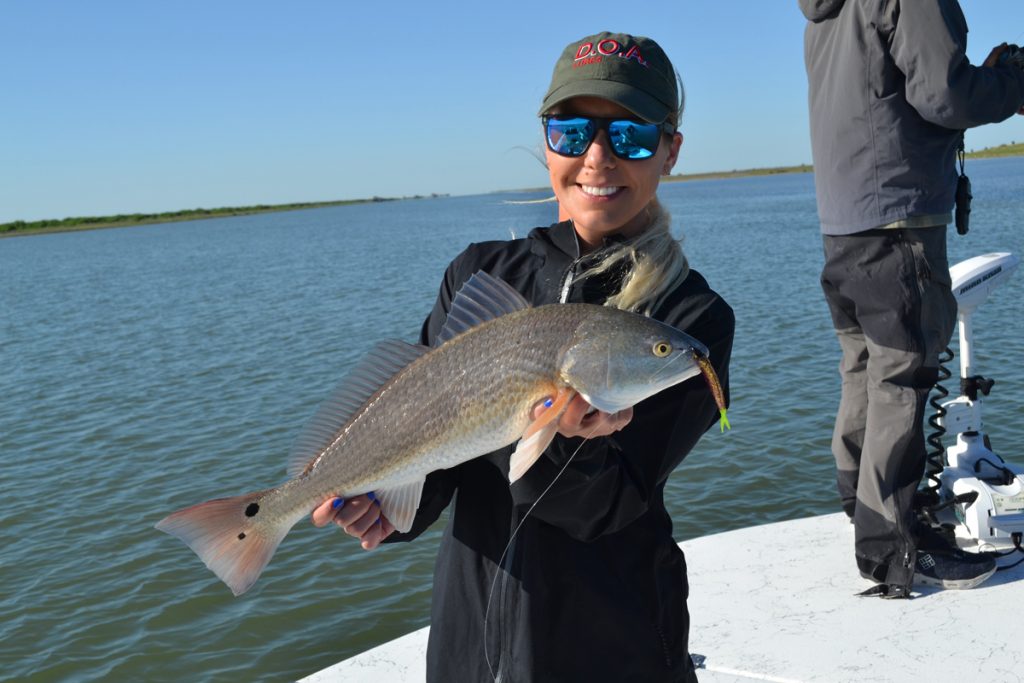
My first fish of the day and it was a pretty one.
Photo: Brian Barrera
I want to give a big thanks to Joey Farah for the invitation to the D.O.A. Lures Outdoor Writers Event. Thank you for the great memories while testing these fish-catching lures in your backyard. Next time we’re surfing too! I’m forever grateful to Mark Nichols, Ed Zyak, Brian Barrera, and Ruby Delgado of D.O.A., you guys are amazing. Also, thank you Taylor Winzeler from Laguna Madre Clothing Co. for supplying us with top notch fishing apparel. As for Chef Jeff and Marker 37 Marina, I can’t say enough good things about how well they treated us. I will be back soon!
The weather is only getting better and the Upper Laguna Madre fishery is phenomenal, so if you would like to fish this area, contact any of these knowledgable and upstanding guides; Capt. Joey Farah, Capt. Bartt Caron, Capt. Braeden Thomas and Capt. Andrew Lassiter.
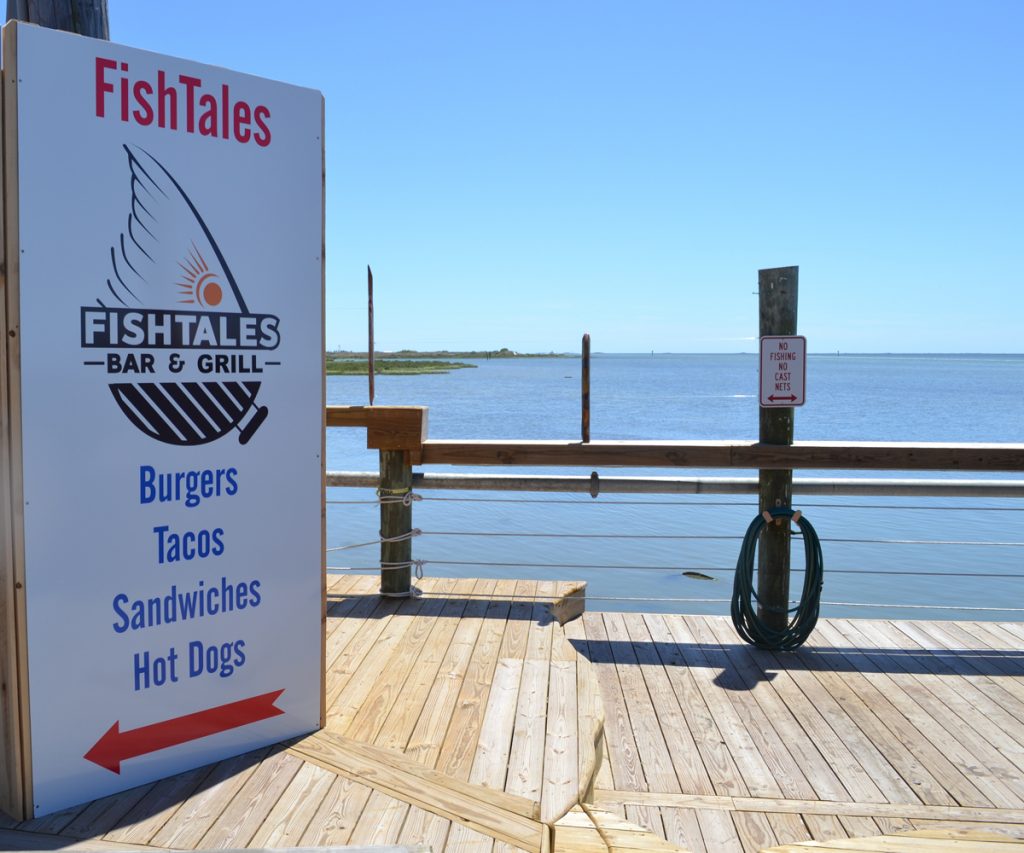
Fishtales Bar & Grill at Marker 37 Marina is the perfect place to enjoy a meal by Chef Jeff after a day on the water. Photos: Kelly Groce




 Make protection from the sun a priority
Make protection from the sun a priority
 That’s a paddlin’! Tales and observations from a floating piece of plastic
That’s a paddlin’! Tales and observations from a floating piece of plastic

















































